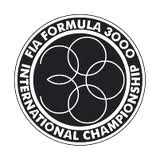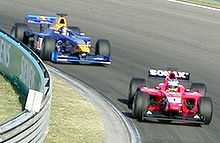International Formula 3000
 | |
| Category | Single seaters |
|---|---|
| Country | International |
| Inaugural season | 1985 |
| Folded | 2004 |
| Last Drivers' champion |
|
| Last Teams' champion |
|
The Formula 3000 International Championship was a motor racing series created by the Fédération Internationale de l'Automobile (FIA) in 1985 to become the final preparatory step for drivers hoping to enter the Formula One championship. Formula Two had become too expensive, and was dominated by works-run cars with factory engines; the hope was that Formula 3000 would offer quicker, cheaper, more open racing. The series began as an open specification, then tyres were standardized from 1986 onwards, followed by engines and chassis in 1996. The series ran annually until 2004, and was replaced in 2005 by the GP2 Series.
The series was staged as the Formula 3000 European Championship in 1985,[1] as the Formula 3000 Intercontinental Championship in 1986[2] and 1987[3] and then as the Formula 3000 International Championship from 1988[4] to 2004.[5]
Engines
Formula 3000 replaced Formula Two, and was so named because the engines used initially were 3.0 L (183ci) Cosworth DFV engines made obsolete by popularization of 1.5 L turbocharged engines in Formula One (it has been observed Bernie Ecclestone had purchased a job-lot of DFVs in 1984, with no obvious use for them at the time).
The rules permitted any 90-degree V8 engine, fitted with a rev-limiter to keep power output under control. As well as the Cosworth, a Honda engine based on an Indy V8 by John Judd also appeared; a rumoured Lamborghini V8 never raced. In later years, a Mugen-Honda V8 became the thing to have, eclipsing the DFV; Cosworth responded with the brand new AC engine. Costs, not unlike the senior series, were getting out of control.
Chassis
01.jpg)
The first chassis from March, AGS and Ralt were developments of their existing 1984 Formula Two designs, although Lola's entry was based on and looked very much like an IndyCar. A few smaller teams tried obsolete three-litre Formula One cars (from Tyrrell, Williams, Minardi, Arrows and RAM), with little success—the Grand Prix and Indycar-derived entries were too unwieldy—their fuel tanks were about twice the size of those needed for F3000 races, and the weight distribution was not ideal. The first few years of the championship saw March establishing a superiority over Ralt and Lola—there was little to choose between the chassis, but more Marches were sold and ended up in better hands. The form book was rewritten in 1988 with the entry of the ambitious Reynard marque with a brand new chassis; Reynard had won their first race in every formula they'd entered. This would continue in F3000. The next couple of years saw Lola improve slightly—their car was arguably marginally superior to the Reynard in 1990—and March slip, but both were crushed by the Reynard teams and by the mid-90s, F3000 was a virtual Reynard monopoly, although Lola did eventually return with a promising car and the Japanese Footwork and Dome chassis were seen in Europe. Dallara briefly tried the series before moving up to Formula One, and AGS moved up from Formula Two but never recaptured their occasional success. At least one unraced F3000 chassis existed—the Wagner fitted with a straight-six short-stroke BMW. This was converted into a sports car, however.
Politics
The series was not without controversy. Definitive rules for the 1985 season did not appear until the championship was well under way. In 1987 questions were asked about the ability of some of the drivers, given the high number of accidents in the formula. In 1989 the eligibility of the new Reynard chassis was challenged - it was raced with a different (but safer and no faster) nose to the one that had been crash tested. This season also saw problems with driver changes - the cost of F3000 was escalating to the point that teams were finding it difficult to run drivers for a whole season. A badly implemented "two driver changes per car per season" rule meant that some cars had to sit idle while drivers with budgets could not race them (rather than allowing two drivers to share a drive through the season on a race-by-race basis, teams could only change the driver of any entry twice in a year). In 1991 the performance of some Italian teams attracted attention - they had started using Agip's "jungle juice" Formula One fuel, worth an estimated 15 bhp—giving their drivers a significant advantage. In the early years of the formula there was much concern about safety, with a high number of accidents resulting in injuries to drivers and, unfortunately, one fatality in the International Championship - Marco Campos in the very last round of the 1995 series.
Races
Formula 3000 races during the "open chassis" era tended to be of about 100–120 miles in distance, held at major circuits, either headlining meetings or paired with other international events. The "jewel in the crown" of the F3000 season was traditionally the Pau Grand Prix street race, rivalled for a few years by the Birmingham round. Most major circuits in France, Italy, Spain, Germany and the United Kingdom saw the series visit at least once.
The spec-chassis years
In 1996, new rules introduced a single engine (a detuned Judd V8 engine, re-engineered by and badged as a Zytek) and chassis (Lola), to go along with tyre standardization (Avon) introduced in 1986. The following year the calendar was combined with that of Formula One, so the series became support races for the Grand Prix. Several Grand Prix teams established formal links with F3000 teams to develop young drivers (and engineering talent); these relationships varied from formal "junior teams" (such as the one McLaren set up for Nick Heidfeld) to fairly distant relationships based mostly upon shared sponsors and the use of the 'parent' team's name. The series grew dramatically through the late nineties, reaching an entry of nearly 40 cars - although this in itself was problematic as it meant many drivers failed to qualify. In 2000, the series was restricted to 15 teams of two cars each.
However, by 2002 expenses were once more very high and the number of entries, and sponsors, rapidly dwindled. International Formula 3000 was experiencing tough competition with cheaper formulae, such as European F3000 (using ex-FIA 1999 and 2002 Lola chassis), World Series by Nissan (also known as Formula Nissan) and Formula Renault V6 Eurocup. By the end of 2003, car counts had fallen to new lows.
The 2004 season was the last F3000 campaign, due in part to dwindling field sizes. In 2005 it was replaced with a new series known as GP2, with Renault backing.
Champions
- For a complete list of drivers, see List of International Formula 3000 drivers.

Three past F3000 champions (Müller, Junqueira and Wirdheim) have never been entered in an F1 race. Bourdais, Fittipaldi, Junqueira, Montoya, Moreno, Wilson and Wirdheim have all raced in Champ Cars. Müller became a BMW driver in WTCC touring car racing after having been a test driver for the BMW-Williams F1 project in 1999 as well as a racer of the BMW V12 LMR Le Mans winner. Sospiri attempted to qualify for one Formula One race but failed to make it, as part of the disastrous MasterCard Lola team. Wirdheim has been third driver in practice sessions for Jaguar Racing, but has never participated in a race.
Three past F3000 champions have won an F1 Grand Prix: Alesi, Panis and Montoya (who also won the Indy 500 once). By taking the 2008 World Drivers Championship, Lewis Hamilton became the first ever European Formula Two, Formula 3000 or GP2 champion to become World Champion (although Alberto Ascari won the World Championship for two years running when all World Championship races apart from the Indianapolis 500 were run to Formula Two rules).
Other F3000 series
- Auto GP (formerly Italian Formula 3000, Superfund Euro Formula 3000 and Euro Formula 3000, Euroseries 3000), active 1999 onwards.
- Japanese Formula 3000 (now Formula Nippon), active 1973 onwards (1987–1995 as Japanese F3000).
- British Formula 3000 (also known as British Formula Two), active 1989–1994 (1989–1992 as British F3000).
- OzBoss (formerly known as Australian Formula 4000, Formula 4000, Formula Holden and Formula Brabham), active 1989 onwards (used mostly F3000 chassis 1989–2006).
- American Racing Series/Indy Lights, active 1986 onwards (used F3000 chassis 1986–1992).
References
External links
| Wikimedia Commons has media related to International Formula 3000. |
| ||||||||||||||